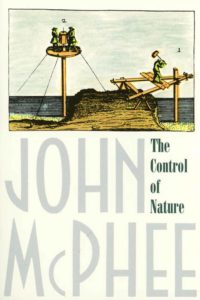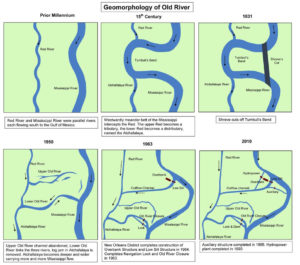
Approximately 30 years ago, the head of our company gave me (as he did to others) a copy of the book The Control of Nature by John McPhee. I’m sure he thought that this would be a good book for civil engineers to read. Well, it took me a while to get to it, but I finally did, reading it over the summer. The reading ran a little longer than it probably should have. 288 pages long, I think it took me close to a month to read in ten page sittings.
The book is in three sections, each dealing with a case where man has battled what the natural world is doing in a place where man doesn’t want change to happen to his built environment. The first is where the Mississippi River, in its meanderings upstream of Baton Rouge, it trying to spill out into the Atchafalaya River, which is known as a distributary.

This is flat country. The river flows slowly, but it has a lot of water in it. Some of that water escapes from the Mississippi River watershed into the Atchafalaya River watershed. This has been going on for a long time (as in centuries), but is slowly accelerating. If nature had its way, just about all of the Mississippi would have, by now, been re-routed into the Atchafalaya. The Lower Mississippi will have ceased to be a major river, and New Orleans and Baton Rouge would have become untenable as major ports.
We can’t let that happen the Corps of Engineers decided over 60 years ago. So they built control structures. The first one worked, but wasn’t enough. So they built another, and another. Then the floods came, and everyone involved held their breath to see what would happen. The structures held. The “father of rivers” stayed in its banks. The control structures let water through, but just enough to keep the Atchafalaya flowing as it’s supposed to.
McPhee goes into great detail about how this all came about, how it is being maintained, and what the (then, around 1988) future was likely to hold. The structures had held up for a couple of major floods, though sustained wear and tear. What would happen in the future.

It occurred to me that if these structures were still standing I ought to be able to find them on Google Earth. Sure enough, there they are, though added to since McPhee wrote about them. They now include a hydroelectric structure on one overflow channel. The next photo, from closer in shows water flowing in the channels. The Corps couldn’t completely shut off the Atchafalaya, so the structures were built not to hold back the flow completely, but to allow just the right amount through.

This part of the book is fascinating. McPhee talked about the history of the rivers and the structures, but also about the present, that is the end of the 1980s present. He interviewed people who operated and maintained the structures. He interviewed those who lived nearby and how all of this affected them. And he interviewed those who were planning for the future.
In fact, those interviews give rise to my main criticism of the book. Sure, they were interesting, but they were too many and too long. They made into 90 pages what could have easily been told in 60 with no loss of interest, at least for me. And, as I go through this review, you’ll find that’s my complaint throughout.
But, I’m going to split this review up into three parts and won’t give my overall conclusion or rating until the end of the third part. I will say that, as an engineer whose career was mainly about the flow of water (sometimes sewage) through pipes and channels, this part of the book was fascinating to me. I also think non-engineers will find the book of interest. In fact, perhaps those many interviews will provide much enjoyment to those not so caught up in the engineering of the project.
Stay tuned for parts 2 and 3, coming at some point.